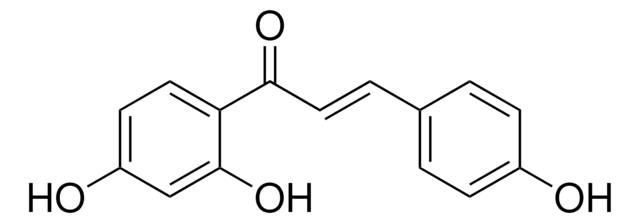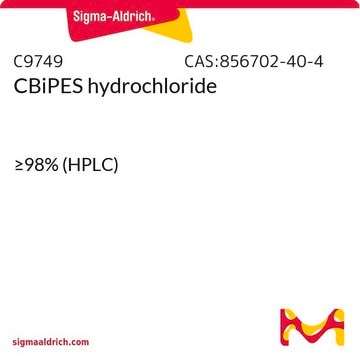B178
Butein
solid
Synonyme(s) :
1-(2,4-Dihydroxyphenyl)-3-(3,4-dihydroxyphenyl)-2-propen-1-one, 2′,3,4,4′-Tetrahydroxychalcone
About This Item
Produits recommandés
Forme
solid
Couleur
yellow
Solubilité
DMSO: >50 mg/mL
H2O: insoluble
Chaîne SMILES
OC1=CC(O)=C(C(/C=C/C2=CC(O)=C(O)C=C2)=O)C=C1
InChI
1S/C15H12O5/c16-10-3-4-11(14(19)8-10)12(17)5-1-9-2-6-13(18)15(20)7-9/h1-8,16,18-20H/b5-1+
Clé InChI
AYMYWHCQALZEGT-ORCRQEGFSA-N
Informations sur le gène
rat ... Alox5(25290)
Vous recherchez des produits similaires ? Visite Guide de comparaison des produits
Description générale
Actions biochimiques/physiologiques
Caractéristiques et avantages
Attention
Code de la classe de stockage
13 - Non Combustible Solids
Classe de danger pour l'eau (WGK)
WGK 3
Point d'éclair (°F)
Not applicable
Point d'éclair (°C)
Not applicable
Équipement de protection individuelle
Eyeshields, Gloves, type N95 (US)
Faites votre choix parmi les versions les plus récentes :
Déjà en possession de ce produit ?
Retrouvez la documentation relative aux produits que vous avez récemment achetés dans la Bibliothèque de documents.
Articles
Discover Bioactive Small Molecules for Kinase Phosphatase Biology
Active Filters
Notre équipe de scientifiques dispose d'une expérience dans tous les secteurs de la recherche, notamment en sciences de la vie, science des matériaux, synthèse chimique, chromatographie, analyse et dans de nombreux autres domaines..
Contacter notre Service technique





![[Arg8]-Vasopressin solution Grade VI (synthetic), ~100 IU/mL in 0.9% NaCl](/deepweb/assets/sigmaaldrich/product/structures/326/242/dede8c26-cf73-4a28-a5d9-1d57c673cf0e/640/dede8c26-cf73-4a28-a5d9-1d57c673cf0e.png)


